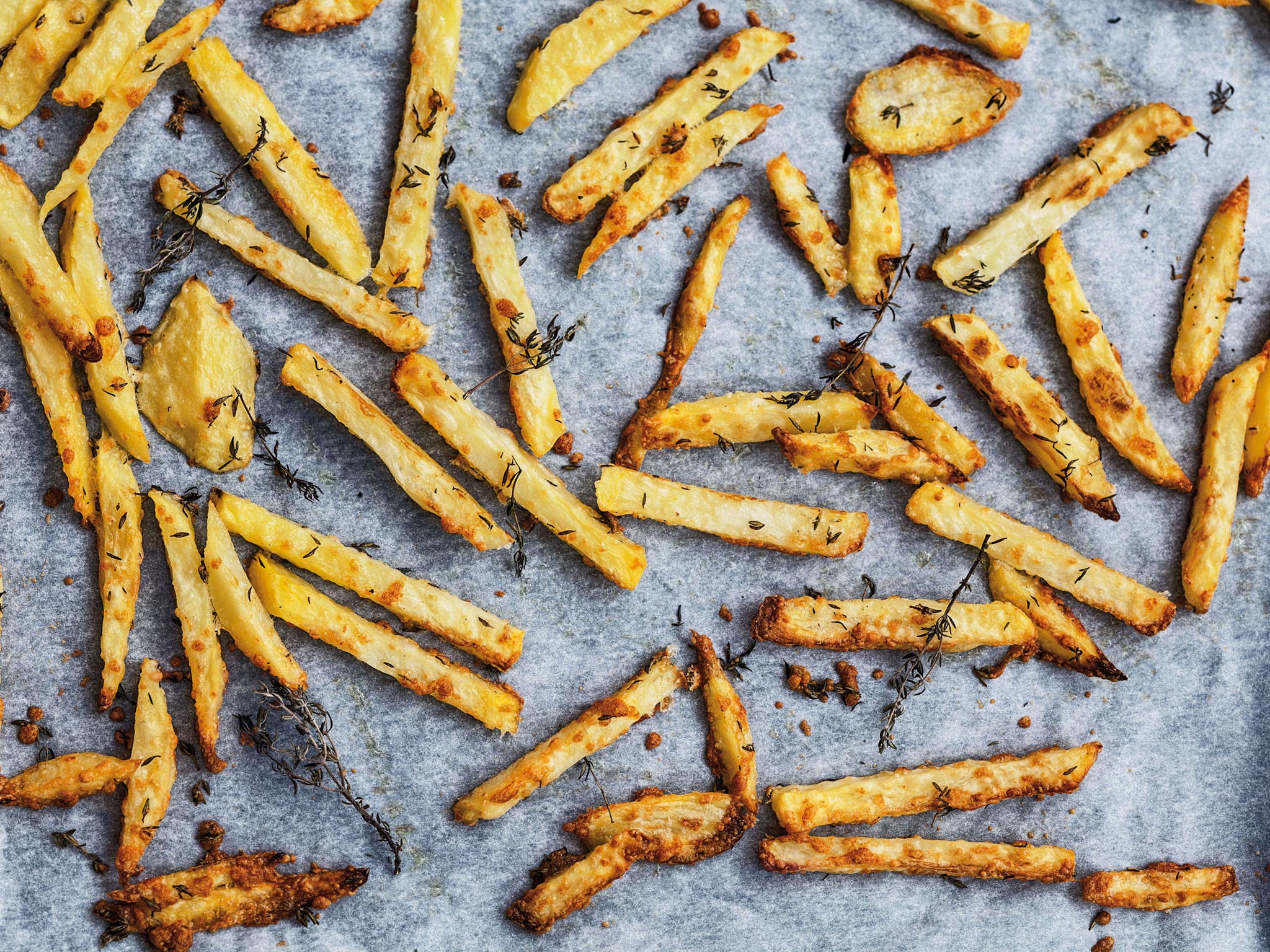Fries are getting a foodie makeover, with 'truffle-topped polenta frites' coming to a menu near you
Emily Jupp finds out whether gourmet chips are just a flash in the pan

Your support helps us to tell the story
In my reporting on women's reproductive rights, I've witnessed the critical role that independent journalism plays in protecting freedoms and informing the public.
Your support allows us to keep these vital issues in the spotlight. Without your help, we wouldn't be able to fight for truth and justice.
Every contribution ensures that we can continue to report on the stories that impact lives

Kelly Rissman
US News Reporter
I think that it all started with the recession. After the 2008 crash, spending was stalled and diners were cautious, unwilling to part with big money for decadent dinners. So street food came along to fill the gap; the squeezed middle couldn't afford steak, but we could still stretch to burgers (not from McDonald's – we wouldn't be seen dead there, even if the cows were raised on the same farm as those of our twice-the-price diner, where food was grabbed from a temporary hatch in the wall).
It's an important point to make, that the middle-class supper clubs were similar to, yet distinctly different from, the ubiquitous fast-food joints that had existed before them. The food was made with superior ingredients and cooked with care: this is not just a hot-dog stall, it's a "haute-dog" pop-up; this is not just a burger van, it's a meat wagon. Thus, the middle classes were able to dine out on a tighter budget, while maintaining a snobbishness about working-class food. Marketing genius.
As the likes of burger chain Byron and London-based Chicken Shop continue to make fast food palatable to the middle classes, there's one ordinary foodstuff that's holding out against being gingered up with special sauce, hung for a minimum of 28 days, rubbed with nectar-fed armadillos and piped through Kylie Minogue's golden hotpants before we'll allow it between our pampered lips, and that's the simple, no-nonsense chip. Some 90 per cent of us are chip eaters; from lords and ladies to labourers and layabouts, the chip unites us all.
Perhaps the reason for the unifying nature of chips (chip classlessness, if you will) is that they're uniquely shareable: it's OK to pinch chips from someone else's plate, but any other food would be inappropriate. In Watching the English, a book by the anthropologist Kate Fox offering an insight into English class, the author says chip eating is important as a social facilitator – in other words, it helps us all to get along: "When we are eating chips, you will often see the English behaving in a very sociable, intimate, un-English manner," Fox writes, "all pitching in messily to eat with our fingers off the same plate or out of the same bag, pinching chips off each other's plates – and even feeding chips to each other."
It's a shock, then, that even chips are now undergoing a type of foodie gentrification. No longer are they simply fat or skinny, wrapped or open, crinkle-cut or curly. Now they're triple-cooked, duck-fat-fried, soaked in dripping, hand-cut, topped with pulled pork, doused with truffle oil or even – heaven forbid – not made from potato at all.
Anne de la Forest, a French cook and food journalist, is pioneering a trend for "frites" that many of us might argue are not chips, but something else entirely. Her recipe book, Frites, is divided into sections: Trendy Frites, including skinny chips, honey-glazed, polenta and feta fries (which are deep-fried cheese in breadcrumbs); Creative Frites: made with assorted veg such as sweet potato; and Sweet Frites: desserts made from apples, bananas and pears, sliced into oblongs and deep-fried. I feel horrified at the idea of chips being messed about with, but de la Forest insists she understands the special place chips have in our hearts.
"Fries are emotional!" she says. "Chips were cooked by our grandmother or mother, eaten with family, the food we adore to eat with our fingers... My first memories of chips are those that I made with my mother, eaten with a juicy steak, the juice of the meat impregnating the chips – totally delicious."
It was when she tried to look for a good chip recipe to prepare some for her children that she realised that food fetishisation did not extend to the potato-based snack, and decided to make amends, experimenting with different fruit and vegetables, different thicknesses, the benefits of machine-cut versus hand-chopped, different oils and frying temperatures, until Frites was born. On her deep-frying odyssey she discovered something that we all suspected – that cooking up a chip isn't that complicated.
"The secret to cooking good fries is based on three things: the variety of potatoes, which must be mealy but not too dry, good cooking oil and double firing, with a first bath at 130C and a second bath at 170C/180C," says de la Forest.
I tested her recipes on some friends to see if these mutant chips were really any better than the usual chip-shop sort, with mixed results. One discovery: the oil is terribly important. You need oil that will remain stable even at very high temperatures and rich in saturated fatty acids – not good for your arteries, but it makes for delicious chips. De la Forest encourages experimenting with oils, so after some failed attempts I plumped for rapeseed oil and another oil that was a combination of avocado, sesame and canola oil, which has a high boiling point but is still more nutritious than vegetable or sunflower oil. Most of the recipes recommend using a deep-fat fryer but I just used a pot filled half-full with oil and fished the chips out with a slatted spoon (get a sober adult to help you with this). Here's what occurred:
Experiment one: courgette chips
Byron makes these. Its version are salty and tasty but a bit on the damp side, so I took precautions by salting the courgette slices and leaving them for half an hour to draw out the liquid, then dried them with paper towels before frying. I couldn't get poppy seeds, so swapped them for sesame seeds instead, which worked well.
The verdict: my victims loved the sesame crust but the courgette's fundamental unchippiness was divisive. "They're very nice, darling, but frankly they just aren't chips," was my boyfriend's response.
Experiment two: asparagus chips
It isn't even possible to carve these into a chip-like shape, so they weren't even masquerading as chips when I served them with a herby dip. I think that this helped, because they weren't being judged against traditional chips.
The verdict: crispy on the outside, fresh on the inside and a good shape for dipping. A success.
Experiment three: polenta chips
I had to fry these for seven minutes, which is double the recommended frying time, to get them really crispy on the outside. I sprinkled them with smoked rock salt and served them with mayonnaise and ketchup.
The verdict: they were very well received. My friend Gary said: "I like them because they are the most like real chips." High praise indeed.
Experiment four: feta chips
The breadcrumb batter stuck well to these, creating a crispy shell and a gooey interior.
The verdict: these were the favourites in the group, but then who doesn't love tangy deep fried cheese?
Experiment five: sweet-potato chips
This was dessert. Like traditional chips, sweet potato produces a lovely chip when baked, so I went against the recipe and parboiled them and then shoved them in the oven with vanilla sugar for 20 minutes.
The verdict: the women in the group loved them, but the men were perturbed by the sweet/savoury combination of potato chips.
Conclusion
For a pretentious dinner party, these hybrid chips might be a good talking point, but it's safe to say that potato chips aren't going to be swept away entirely by the foodie revolution. With its fluffy centre that knows no prejudice and crispy skin that sees no class distinctions, the potato remains the best vegetable for frying up. When the chips are down, potato-based comfort food is the only thing I want on my plate.
COURGETTE, PARMESAN AND POPPY-SEED FRITES
By Anne de la Forest
Ingredients to serve 6
1 kg courgettes
2 eggs
2 tablespoon flour
3 tablespoons dried breadcrumbs
2 tablespoons parmesan,
grated
1 teaspoon of poppy seeds
2 litres cooking oil
Table salt
Freshly ground black pepper
Heat the fryer (or a pot of oil) to 170C. Wash the courgettes well and dry them carefully with a clean, dry cloth. Cut the courgettes lengthways into large slices and then cut them again into fairly thin sticks about 10cm long.
Beat the eggs in a bowl, put the flour into a second bowl and mix the breadcrumbs, parmesan and poppy seeds in a third. Add salt and pepper to all three bowls.
Dip the courgette pieces first in the flour, then in the eggs and finally in the breadcrumb mixture. Place each one carefully in the frying basket.
Fry for 5 minutes, keeping a close eye on them. Remove the courgette frites from the fryer. Salt generously and enjoy whilst still hot.
POLENTA FRITES
BY Anne de la Forest
Ingredients to serve 6
300ml milk
300ml water
150g polenta
1 tablespoon parmesan, grated
1 tablespoon melted butter
2 litres cooking oil
1 teaspoon table salt
Half a teaspoon sea salt crystals
Bring the milk and water to the boil together. Sprinkle in the polenta and allow to cook for 10 minutes, stirring until it thickens. Add the parmesan and melted butter. Salt generously and stir well.
Spread the polenta out on a flat dish, in an even layer about 2cm or 3cm thick and leave to cool. Then put it in the fridge for one hour.
Heat the fryer to 170C. Cut the polenta into sticks about 10cm long. Put the sticks carefully into the frying basket, using tongs. Space them out well. Lower the basket and fry for two minutes. Lift out the basket, let the frites drain, then place them carefully on a large plate covered with kitchen paper. Remove the paper.
Sprinkle lightly with sea salt and eat whilenice and hot.
Join our commenting forum
Join thought-provoking conversations, follow other Independent readers and see their replies
Comments